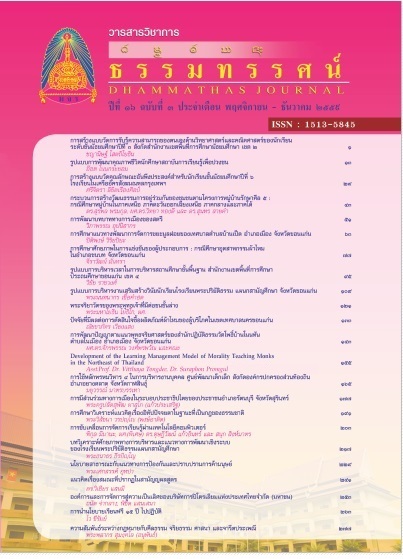Development of the Learning Management Model of Morality Teaching Monks in the Northeast of Thailand
Main Article Content
Abstract
Abstract
The aims of this research were 1) to study need conditions for developing the learning management model of the morality teaching monks in the schools in the northeast of Thailand, 2) to develop the model of learning management and 3) to evaluate the use of the model. The population used to in this study referred to those, who involved in the project ‘Morality Teaching Monksin Schools’ in Khon Kaen, Kalasin, Roi-et and Maha Sarakham provinces, including 5 experts, 20 educational administrators, 10 project officials, 200 students, 200 morality teaching monks (total 435). The tools used were a questionnaire and an interview form. The statistics: Mean and Standard Deviation were used to analyze the quantitative data. For the qualitative data, the contents and contexts from the interview were primarily investigated.
The research results were as follows:
1. According to the need of the model for managing Buddhist learning, it was suggested that the model which has the contents related to the Buddhism learning standards in each learning level was needed because this would result in understanding of the students on the history and importance of Buddhist principles in each level. This also causes them to followthe morality of good conducts, esteem and faith in Buddhism and behave according to Dhamma, Buddhist rituals and apply them to self development, social and environmental benefits and peaceful co-existence.
2. The model of learning management of the morality teaching monks was very accurate and was appropriated in use. It was composed of four models: 2.1) the model of Buddhism learning management for the primary school class 01 (years 1-3), 2.2) the model of Buddhism learning management for the primary school class 02 (years 4-6), 2.3) the model of Buddhism learning management for the secondary school class 03 (years 1-3) and 2.4) the model of Buddhism learning management for the primary school class 04 (years 4-6).
3. The results of the model evaluation indicated that for the informants’ agreement evaluation based on the Likert scale, the overall statistic scores of all classes were at a high level (agree). Based on the consideration of each aspect, it was found that the score of the aspect that the morality teaching monks have managed the learning in terms Dhamma was higher than those of other aspects, followed by that of the aspect of Buddhism learning management and Sangha learning management. The overall satisfaction score of those who involved in the project was a high level (satisfied). Based on consideration of each group of the population, it was found that the students were most satisfied with the model, followed the officials and the educational administrators respectively.
4. The outcomes of this study revealed that the morality teaching monks in the schools have managed Buddhism learning at a high level (satisfied) based on statistic score consideration and the score of the satisfaction of those involved was the same. This reflects the view of the schools showing that the morality teaching monks have played an important role in Buddhism learning management. Therefore, the project director and those who involved should continue the project in Thailand.
Article Details

This work is licensed under a Creative Commons Attribution-NonCommercial-NoDerivatives 4.0 International License.
เพื่อให้เป็นไปตามกฎหมายลิขสิทธิ์ ผู้นิพนธ์ทุกท่านต้องลงลายมือชื่อในแบบฟอร์มใบมอบลิขสิทธิ์บทความ ให้แก่วารสารฯ พร้อมกับบทความต้นฉบับที่ได้แก้ไขครั้งสุดท้าย นอกจากนี้ ผู้นิพนธ์ทุกท่านต้องยืนยันว่าบทความ ต้นฉบับที่ส่งมาตีพิมพ์นั้น ได้ส่งมาตีพิมพ์เฉพาะในวารสาร วิชาการธรรม ทรรศน์ เพียงแห่งเดียวเท่านั้น หากมีการใช้ ภาพหรือตารางของผู้นิพนธ์อื่นที่ปรากฏในสิ่งตีพิมพ์อื่นมาแล้ว ผู้นิพนธ์ต้องขออนุญาตเจ้าของลิขสิทธิ์ก่อน พร้อมทั้ง แสดงหนังสือที่ได้รับการยินยอมต่อบรรณาธิการ ก่อนที่บทความจะได้รับการตีพิมพ์